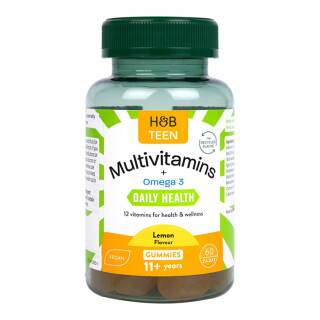We all have an immune system that helps to protect us from disease.
In babies and children, the immune system that will serve them throughout their lives is still developing.
This means that, for little ones, a healthy diet, good hygiene, and an up-to-date vaccination profile are key.
We’ve received guidance from The Children’s Nutritionist Sarah Almond-Bushell, who’s a registered dietician and children’s immunity expert.
- What the immune system is and why it’s important
- Vaccination for children and babies
- How you can support your baby’s immune system
- How you can support you child’s immune system
By making some small lifestyle changes, you can support your child’s developing immune system. Seek advice from your child’s GP if you’re concerned.
1. Vegetables
We know, we know. Making sure your child gets the recommended five portions of fruit and vegetables a day isn’t easy, especially if they’re a fussy eater.
However, vegetables are so important for a child’s strong immune response; it’s worth making this a priority.
Aim to include plenty of veg with red, orange, and yellow hues or dark green colours as this means they’ll be getting in their vitamin C and carotenoids, which are proven to support the immune system.1,2
Serve up some orange peppers, sweet potatoes, tomatoes, broccoli – and Brussels sprouts, if you’re feeling festive!
Eating vegetables doesn’t come naturally to most children because of their bitter flavours. Here are some tips to help your child become familiar with vegetables:
Shop together
Young children take cues from their parents, so try to appear excited at the prospect of choosing things in the fruit and veg section of the supermarket.
Kids also love to be independent, so allow your child to pick out the fruit or veg they like the look of for dinner.
Think like a child
Young children make their decisions about food based on what it looks like.
Food manufacturers and supermarkets know this, which is why brightly coloured packets with cartoon characters are placed at children’s eye level as you walk around the shops.
And when you know this, you can make food fun too:
- Use cookie cutters to make flower-shaped cucumber
- Choose a range of different coloured fruit and veg and arrange them like a rainbow
- Make cauliflower sheep and broccoli trees
When food is fun, it’s interesting, and when it’s interesting it has a better chance of being eaten.
Change the dialogue
Rather than telling them to eat their broccoli or bribing with a dessert, try not to make any comment on your child’s eating performance at all.
Often, our words of encouragement actually stop children from eating because they feel under pressure.
And pressure causes a spike in adrenaline, which switches appetite off.
Repeated Exposure
Learning to like food is actually a 32-step process that starts with the sensory system.
This means that children often need to be exposed to food time and time again before they will decide to try it.
Helping you prepare and cook food is a really great way to offer this exposure in a low-pressure way.
Children as young as 1 can help wash veggies or tear lettuce, and older children can help peel and grate carrots or chop salad.
Disguise them – but be honest
If you really need to, you can disguise food by blending fruit and vegetables into your child’s favourite foods. But be honest with them about what they’re eating.
If they find a bit of unblended green stuff, that could mean the end of the favourite food too! It could also cause lasting damage on the trusting feeding relationship between you.
You can add carrots and peppers in pasta sauce, sweet potato baked “fries”, cauliflower in macaroni cheese… there are plenty of ways to get resourceful.
Just be mindful that children need to see a food to learn to like it, so hiding foods is not a long-term solution.
2. Oily fish
DHA is an essential fatty acid found in oily fish like salmon, mackerel, and sardines. It’s known to be beneficial for the immune system.3It’s called essential because the body can’t make it, so it has to come from food.Children should eat one to two portions of oily fish per week.4 Serve it in appealing ways – e.g. tacos, mashed with potato, or in pasta. Always try to remove bones.For an easy school lunch, send them off with some mackerel or salmon sandwiches with mayo for a little extra flavour.Unfortunately, tuna doesn’t count as an oily fish, and neither does white fish like cod or haddock.
Just like veg, fruit is another abundant source of immune-supporting nutrients. Most children will happily eat fruit because it’s sweet.
Citrus fruits are particularly high in vitamin C, which is thought to increase the production of white blood cells (which fight off infection). Try oranges, grapefruit, tangerines, or clementines.
Kiwi, papaya, and strawberries are all super-high in vitamin C, too.
If your child isn’t keen on eating fruit whole, a quick and easy way to get its goodness in is with smoothies.
Whip up your own in a blender to reduce the free sugars you get in shop-bought versions. You could even throw in a little carrot, spinach, or cucumber for some veggie action too!
Smoothies also make excellent ice lollies when frozen for a child-approved summer treat.
4. Vitamins for kids’ immune systems
If you’ve got a fussy child who isn’t the biggest fan of fruit and veg, try getting them some of the best vitamins for kids’ immune systems.
A daily supplement can top up your child’s diet and help fill the gaps in their nutrition to support their immunity.
Choose a sugar-free chewy gummy multivitamin that includes vitamin C, a potent antioxidant that contributes to immune defence.5
5. Quality sleep
Sleep is key for a strong immune system both in childhood and throughout life.6
Use this guide for the number of hours children need at each stage of development:
- Toddlers aged 1 – 2 need 11 – 14 hours
- Kids 3 – 5 years need 10 – 13 hours
- Kids 6 – 12 need 9 – 12 hours
- Teens 13 – 18 need 8 – 10 hours7
If you have older and younger children, staggered bedtimes might be needed.
6. Teach good hygiene
One of the main reasons children have more coughs and colds is because they play in close proximity with other children and they haven’t yet mastered hygiene.
Germs can be spread easily, so it’s helpful to teach your child to catch any sneezes in a tissue and to cover their mouth when they cough.
Teach children the importance of washing their hands before meals and after going to the toilet.
These actions will kill bugs and germs and minimize their opportunity to spread.
If someone in your household does become ill, you should make sure you disinfect surfaces even more than usual and that you wash towels and bedding at 65°C.
7. Get active together
Being active supports immunity and reduces the risk of becoming ill.8
NHS guidelines recommend that children aged 5-16 do 60 minutes of aerobic exercise every day.9
This means exercise that’s enough to make them hot and have rosy cheeks, and teens should feel sweaty.
Encourage children to join a football or rugby team, take up athletics, go trampolining, or sign up for dancing lessons. They’re more likely to maintain exercise they enjoy.
Choose something to do together as a family and be a good role model for your children. Simply walking to your local park for a kickabout or going for a bike ride after school is perfect.
8. Get strict about smoke
Smoking weakens our immunity against infections.10
This is also true of second-hand smoke, so if someone in the household smokes, your children are breathing in more than 7000 harmful chemicals every day.11
Ask them to smoke outdoors, away from children, and to keep all doors and windows shut.
And if they can, they should try to stop – children of smokers are more likely to become smokers themselves.12
9. Minimise sugar
A diet too high in refined sugar is bad news for the immune system.13
This is partly because studies have shown that too much sugar can interfere with your body’s uptake of immunity superhero vitamin C.14
According to the NHS, children aged 4-6 should have no more than 19g added sugar per day, and children 7-10 should not exceed 24g.15
Try to limit the amount of cakes, sweets, chocolate, fizzy drinks, biscuits, and ice cream your children have on a daily basis.
10. Help to reduce their stress
The past couple of years have been hard for all of us, but it’s easy to forget how it might have taken a toll on our kids.
Children’s mental health needs to be taken into consideration too.
This may also keep them fighting fit and better protected from any viruses at bay, as chronic stress has been shown to negatively impact the immune system.16
- Sleeping well
- Exercise
- Seeing friends
- Having fun
- Getting outdoors, and
- Having a routine
can all help keep stress levels down. Some children may also benefit from mindfulness exercises or journalling, too.
*source hollandandbarrett.com, by Sarah Almond Bushell, Registered Dietitian & Children’s Nutritionist

















